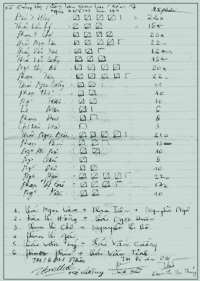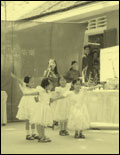| home |
Projects
Beneficiary Families

Who benefits?
Breakdown by age of beneficiaries
| Children 0-19 | Women 20-49 | Men 20- 49 | Elderly 50+ |
| 46% | 20% | 20% | 14% |
The project's actions target poor and vulnerable families. Women participate significantly in the project’s activities, and 40% of the beneficiary families involved in house strengthening has been headed by women, who participate directly and efficiently in the animation and communication activities. Many are proud of what they have achieved and share their experience.
The family group is central to the implementation of a family based vulnerability reduction process.
Family groups for damage prevention
The community and potential beneficiary families in a village collectively select the families who are directly helped by the project. Everyone participates in decisions about which families should have priority for support, to get a subsidy and possibly access to the commune house strengthening credit fund.
Once the group is formed they provide support in the management of credit for house strengthening, and they participate in assessing what work needs to be done. Through experience gained with the project, these families become a focal point for sharing information and their experience. A group leader represents the views of the family group at commune level.
The project works with the selected families to show how existing buildings can be strengthened simply and efficiently in a manner that is sympathetic to local tastes and visual preferences. Respect of local styles is important in developing local acceptance of techniques that can be used. Families always contribute both in kind and financially to the cost of strengthening.
The case of Madam Phan Thi Yêm is quite typical.

Formal record of voting results - for detail click on
image
Selection of beneficiary families
The communes make the final decision, according to the budget and the local situation, on building new houses (Temporary Houses Eradication Programme), and reinforcing existing houses and the proportion of each.
The selection process is democratic and based on priorities, and supervised at village level.
- Overall process: for the selection of the families
- List of "Temporary houses – families" drawn up by the Communes – with criteria on the house and on the family;
- List of families volunteering for the reinforcement housing programme;
- Fully participative discussion at village level, amongst families on the priority families list;
- A decision on the work to be carried out and the subsidy required is taken.
- Direct beneficiary family selection criteria
The selection process is based on simple criteria:
- Need for house rebuilding (house structure is extremely weak, and could not be improved);
- Need for house strengthening (thus the house – structure, walls, etc. – exists but is weak);
- Direct or indirect ability (on the part of the family) to carry out the construction;
- Ability to fund part of the work ;
- Families selected on the basis of no risk of leading to conflicts in the hamlet or the village;
- Beneficiaries should have a spirit of solidarity and be willing to spread the word about the DWF project.
DWF participates in the selection process meetings with beneficiary families. The communes identify at hamlet level potential beneficiaries, but the actual selection is done through a democratic process amongst the community in a hamlet. This participative selection process and the DWF direct monitoring of these events, together provide an extremely effective control of beneficiary selection.
See download

